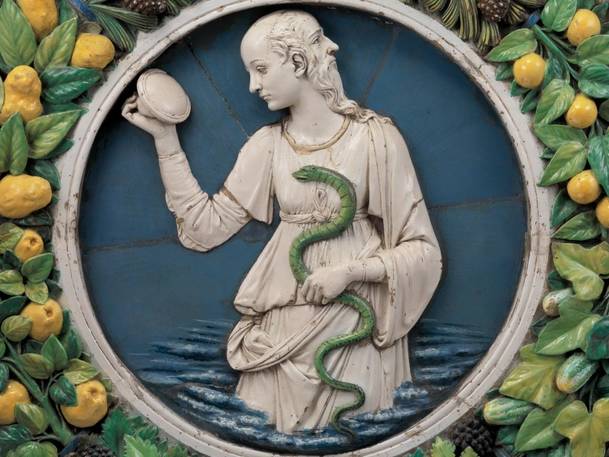


From February 5th to June 4th, the National Gallery of Art [2] will be hosting a fresh retrospective of the three generations of della Robbia sculpture. The national art museum located in Washington D.C. is always free of admission and is known for their diverse collection which varies from elegant Byzantine altarpieces to funky pop art.
This year the museum will feature the work of Luca della Robbia [3] who was an innovative sculptor that lived and worked in Florence during the 15th century. He is credited with developing the particular sculpting technique of colorful tin-glazed terracotta [4]. His eye-catching creations are easily recognizable by their bold shades of blue, brilliant whites, and rich botanical greens. His colorful work can be found all over Italy from the San Giovanni Fuoricivitas [5] church in Pistoia to the charming Pazzi Chapel [6] next to the Santa Croce Basilica [7] in his native Florence.
Highly popular during his time, the gifted sculptor went on to buy a large house which contained a workshop where he then decided to pass his knowledge down onto his nephew, Andrea [8], and his great nephew, Giovanni [9]. This workshop would be the base of the family workshop up until the 1520s, approximately 40 years after della Robbia’s death in 1482.
His specific style not only allowed the pieces to be more vibrant but they were also more durable which is why they became the object of desire for many Americans traveling to Italy during the 19th and 20th centuries with the hopes of bringing a taste of the Renaissance back home. For this reason, a majority of the sculptures presented in this exhibition originally come from private American collections. Meanwhile a couple of other pieces like “La Visitazione” will be on view for the first time ever outside of Italy’s borders. By choosing a more “poor” material like terracotta instead of something more luxurious like marble or bronze, the sculptor was able to make sturdy works of art that could survive centuries without any damage whatsoever.
Armando Varricchio [10], the Italian Ambassador in Washington D.C. commented on the special occasion: “As an Italian I am proud of the fact that an exhibition is being dedicated to the works of della Robbia and his contemporaries because it brings them to the attention of the American public.” He added that ”ingenuity, creativity, and the ability to innovate are the characteristics of these artists but they also perfectly reflect some of the distinctive qualities of Italians in general.”
Renato Miracco [11], the Cultural Attachè at the Embassy of Italy in Washington D.C. also expressed his feelings about the event saying that he is "glad that an underrated art like ceramics and ceramic sculpting is being brought back in style with a gorgeous exhibition like this one."
Please take some time out of your day to visit this show which was organized by the Museum of Fine Arts [12] in Boston in association with the National Gallery of Art with the support of the Italian Embassy in Washington D.C. [13] Research conducted at these institutions along with the Brooklyn Museum [14] and the Metropolitan Museum of Art [15] provide new insight as to how these groundbreaking works were made. A beautifully illustrated book, the first overview of three generations of Della Robbia sculpture in English, will also accompany the exhibition.
Source URL: http://newsite.iitaly.org/magazine/focus/art-culture/article/della-robbia-comes-washington-dc
Links
[1] http://newsite.iitaly.org/files/robbia4jpg
[2] http://www.nga.gov/content/ngaweb.html
[3] https://en.wikipedia.org/wiki/Luca_della_Robbia
[4] https://en.wikipedia.org/wiki/Terracotta
[5] https://en.wikipedia.org/wiki/San_Giovanni_Fuoricivitas
[6] https://en.wikipedia.org/wiki/Pazzi_Chapel
[7] https://en.wikipedia.org/wiki/Santa_Croce,_Florence
[8] https://en.wikipedia.org/wiki/Andrea_della_Robbia
[9] https://en.wikipedia.org/wiki/Giovanni_della_Robbia
[10] http://www.ambwashingtondc.esteri.it/ambasciata_washington/en/aboutus/messaggio.html
[11] https://it.wikipedia.org/wiki/Renato_Miracco
[12] http://www.mfa.org/
[13] http://www.ambwashingtondc.esteri.it/ambasciata_washington/it
[14] https://www.brooklynmuseum.org/
[15] http://www.metmuseum.org/